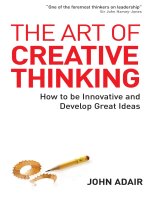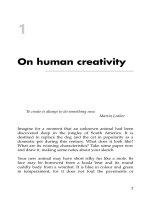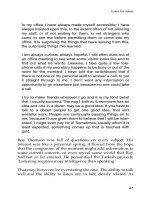the manual of ideas
Bạn đang xem bản rút gọn của tài liệu. Xem và tải ngay bản đầy đủ của tài liệu tại đây (3.9 MB, 338 trang )
The Manual of Ideas
ffirs.indd iffirs.indd i 6/28/2013 1:38:43 PM6/28/2013 1:38:43 PM
ffirs.indd iiffirs.indd ii 6/28/2013 1:38:43 PM6/28/2013 1:38:43 PM
The Manual of Ideas
The Proven Framework
forFinding the Best
Value Investments
JOHN MIHALJEVIC
ffirs.indd iiiffirs.indd iii 6/28/2013 1:38:43 PM6/28/2013 1:38:43 PM
Cover Design: John Wiley & Sons
Cover Image: background texture © iStockphoto.com/kevinruss;
doodles (top and bottom) © iStockphoto.com/vasilki
Copyright © 2013 by John Mihaljevic. All rights reserved.
Published by John Wiley & Sons, Inc., Hoboken, New Jersey.
Published simultaneously in Canada.
No part of this publication may be reproduced, stored in a retrieval system, or
transmitted in any form or by any means, electronic, mechanical, photocopying,
recording, scanning, or otherwise, except as permitted under Section 107 or 108 of
the 1976 United States Copyright Act, without either the prior written permission
of the Publisher, or authorization through payment of the appropriate per-copy fee to
the Copyright Clearance Center, Inc., 222 Rosewood Drive, Danvers, MA 01923, (978)
750-8400, fax (978) 646-8600, or on the Web at www.copyright.com. Requests to the
Publisher for permission should be addressed to the Permissions Department, John
Wiley & Sons, Inc., 111 River Street, Hoboken, NJ 07030, (201) 748-6011, fax (201)
748-6008, or online at />Limit of Liability/Disclaimer of Warranty: While the publisher and author have used
their best efforts in preparing this book, they make no representations or warranties
with respect to the accuracy or completeness of the contents of this book and
specifi cally disclaim any implied warranties of merchantability or fi tness for a particular
purpose. No warranty may be created or extended by sales representatives or written
sales materials. The advice and strategies contained herein may not be suitable for
your situation. You should consult with a professional where appropriate. Neither the
publisher nor author shall be liable for any loss of profi t or any other commercial damages,
including but not limited to special, incidental, consequential, or other damages.
For general information on our other products and services or for technical
support, please contact our Customer Care Department within the United States at
(800) 762-2974, outside the United States at (317) 572-3993 or fax (317) 572-4002.
Wiley publishes in a variety of print and electronic formats and by print-on-demand.
Some material included with standard print versions of this book may not be included
in e-books or in print-on-demand. If this book refers to media such as a CD or DVD
that is not included in the version you purchased, you may download this material at
. For more information about Wiley products, visit www
.wiley.com.
Library of Congress Cataloging-in-Publication Data
Mihaljevic, John, 1976-
The manual of ideas : the proven framework for fi nding the best value
investments/John Mihaljevic.
pages cm.
Includes bibliographical references and index.
ISBN 978-1-118-08365-9 (cloth); ISBN 978-1-118-41889-5 (ebk);
ISBN 978-1-118-41609-9 (ebk)
1. Investment analysis. 2. Value investing. 3. Corporations—Valuation.
4. Portfolio management. I. Title.
HG4529.M54 2013
332.6—dc23
2013012718
ffirs.indd ivffirs.indd iv 6/28/2013 1:38:43 PM6/28/2013 1:38:43 PM
To Mark,
whose courage humbles me
ffirs.indd vffirs.indd v 6/28/2013 1:38:43 PM6/28/2013 1:38:43 PM
ffirs.indd viffirs.indd vi 6/28/2013 1:38:44 PM6/28/2013 1:38:44 PM
vii
Contents
Foreword xi
Preface xiii
CHAPTER 1 A Highly Personal Endeavor: What Do You
Want to Own? 1
Give Your Money to Warren Buffett, or
Invest It Yourself? 2
Cast Yourself in the Role of Capital Allocator 7
Owner Mentality 14
Stock Selection Framework 17
Key Takeaways 18
Notes 20
CHAPTER 2 Deep Value: Ben Graham–Style Bargains
Inelegant but Profi table Strategy of Cigar
Butt Investing 23
The Approach: Why It Works 24
Uses and Misuses of Ben Graham–Style
Investing 34
Screening for Graham-Style Bargains 41
Beyond Screening: Working through a
List of Deep Value Candidates 44
Asking the Right Questions of Graham-Style
Bargains 49
Key Takeaways 53
Notes 54
ftoc.indd viiftoc.indd vii 6/28/2013 1:37:53 PM6/28/2013 1:37:53 PM
viii Contents
CHAPTER 3
Sum-of-the-Parts Value: Investing in Companies
with Excess or Hidden Assets 57
The Approach: Why It Works 58
Uses and Misuses of Investing in Companies
with Overlooked Assets 60
Screening for Companies with Multiple Assets 64
Beyond Screening: Proven Ways of Finding
Hidden Assets 69
Asking the Right Questions of Companies
with Hidden Assets 78
Key Takeaways 81
Notes 82
CHAPTER 4 Greenblatt’s Magic Search for Good and
Cheap Stocks 83
The Approach: Why It Works 84
Uses and Misuses of Investing in Good and
Cheap Companies 91
Screening for Good and Cheap Companies 98
Beyond Screening: Hope for Improvement
Springs Eternal 102
Asking the Right Questions of
Greenblatt-Style Bargains 106
Key Takeaways 113
Notes 114
CHAPTER 5 Jockey Stocks: Making Money alongside
Great Managers 117
The Approach: Why It Works 118
Uses and Misuses of Investing in Jockeys 121
Screening for Jockey Stocks 131
Beyond Screening: Building a Rolodex
of Great Managers 141
Asking the Right Questions of Management 146
Key Takeaways 150
Notes 151
ftoc.indd viiiftoc.indd viii 6/28/2013 1:37:54 PM6/28/2013 1:37:54 PM
Contents ix
CHAPTER 6 Follow the Leaders: Finding Opportunity in
Superinvestor Portfolios 153
Superinvestors Are Super for a Reason 154
Uses and Misuses of Superinvestor Tracking 157
Screening for Companies Owned by
Superinvestors 160
The Superinvestors of Buffettsville 163
Beyond Screening: What Makes a Company
Attractive to Superinvestors? 171
Key Takeaways 175
Notes 177
CHAPTER 7 Small Stocks, Big Returns? The Opportunity
in Underfollowed Small- and Micro-Caps 179
The Approach: Why It Works 180
Uses and Misuses of Investing in
Small Companies 185
Screening for Promising Small- and
Micro-Caps 189
Beyond Screening: Other Ways of
Finding Compelling Small- and
Micro-Cap Ideas 197
Asking the Right Questions of
Small-Cap Prospects 207
Key Takeaways 212
Notes 214
CHAPTER 8 Special Situations: Uncovering
Opportunity in Event-Driven
Investments 215
The Approach: Why It Works 216
Uses and Misuses of Investing in Special
Situations 220
Uncovering Special Situations 227
Asking the Right Questions of
Special Situations 231
ftoc.indd ixftoc.indd ix 6/28/2013 1:37:54 PM6/28/2013 1:37:54 PM
x Contents
Key Takeaways 236
Notes 237
CHAPTER 9 Equity Stubs: Investing (or Speculating?)
in Leveraged Companies 239
The Approach: Why It Works 241
Uses and Misuses of Investing in Equity Stubs 242
Screening for Equity Stubs 251
Beyond Screening: An Ambulance-Chasing
Approach 253
Asking the Right Questions of Equity Stubs 257
Key Takeaways 264
Notes 265
CHAPTER 10 International Value Investments: Searching
for Value beyond Home Country Borders 267
The Approach: Why It Works 269
Uses and Misuses of Investing in International
Equities 272
Screening for International Equities 280
Beyond Screening: Riding the Coattails of
Regional Experts 283
Asking the Right Questions of International
Equities 285
Key Takeaways 291
Notes 292
References 295
About the Author 303
Index 305
ftoc.indd xftoc.indd x 6/28/2013 1:37:54 PM6/28/2013 1:37:54 PM
xi
Foreword
W
hen John asked me to write the foreword to his book, I was
fl attered and honored and immediately agreed to do so. I
agreed because I respect John ’s work and deeply appreciate the
intellectual interchange and things I have learned from reading his
Manual of Ideas periodicals over the years.
John brings a spirit of inquiry to his work and displays a true
thirst for knowledge and understanding in his quest to be a better
investor. More importantly, and very graciously, he doesn ’t keep it
all to himself. He shares his thoughts and acts as a wonderful role
model by showing us how he learns by interacting with other intel-
ligent and dedicated investors.
As John shows us how he learns, we can fi gure out how to
become better learners ourselves.
He also shares some of his life story and how he came to be in
his present circumstances. After you read that section, I think you
will agree that the quest for learning and knowledge, and creativity,
defi nes much of what we are (and should be) as human beings.
There is a true spirit of humility in John ’s work. He understands
that there are multiple ways to think about investing and many dif-
ferent approaches to gaining understanding about what a business
is worth and how that might change in the future. He also under-
stands that those answers may be different in different environ-
ments and for different amounts to invest.
As an investor, I fi nd the single most valuable thing that I
do is to read. I ’ve been a lifelong reader and I thank my parents
for instilling that into me from my earliest memories. As Charlie
Munger once noted, one of the best investments you can make is
buying a book. He went on to note that for just a few dollars, you
fbetw.indd xifbetw.indd xi 04-12-2013 15:42:4504-12-2013 15:42:45
xii Foreword
get man-years of an author ’s life that went into producing that book
for you. I couldn ’t agree more.
I recommend John ’s book as it provides insights and mod-
els and methods to systematically think about the craft of invest-
ing. While all of us seeking to be good value based investors have
different tools and approaches we bring to the task, we can and
should, always continue to learn and adapt and improve our work.
This book helps you do just that. Each chapter provides spe-
cifi c examples and discussions of the ways that successful investors
approach their work. Successful investing is hard and lonely work.
All of the evidence and documentation you can fi nd and demon-
strate relates to the past. Your returns though, come in the future,
and the future is a paradox of things that are similar to what they
were in the past, and different at the same time.
Our challenge as investors is to sort out which is which.
Reading, studying, and thinking about the concepts that John lays
out in this book will help you with that task.
I hope that you enjoy the challenge!
Thomas S. Gayner
President and Chief Investment Offi cer
Markel Corporation
fbetw.indd xiifbetw.indd xii 04-12-2013 15:42:4604-12-2013 15:42:46
xiii
Preface
F
or the solitary endeavor that value investing can be at times, it
has also enriched my life with many friendships and new expe-
riences borne out of those friendships. The value investing com-
munity is diverse, vibrant, and global. I am grateful to have been
deeply involved with VALUEx Zurich/Klosters, the annual gather-
ing of value investors; ValueConferences, the series of online idea
conferences for value investors; and The Manual of Ideas , the
idea-oriented monthly research publication.
Warren Buffett ’s spectacularly successful investment philoso-
phy has found devoted followers on every continent and in virtu-
ally every country. Many of them have used their special talents,
cultural sensibilities, and unique circumstances to succeed at their
own distinct brands of value investing, including Mohnish Pabrai in
the United States, Prem Watsa in Canada, Massimo Fuggetta in the
United Kingdom, Guy Spier in Switzerland, François Badelon in
France, Francisco García Paramés in Spain, Ciccio Azzollini in Italy,
Jochen Wermuth in Russia, Rahul Saraogi in India, Christopher
Swasbrook in New Zealand, and Shuhei Abe in Japan.
We have interviewed more than 100 fund managers across the
globe in preparation for this book, seeking their wisdom on the
topic of idea generation. As such, the following pages feature what
I ’ve learned as managing editor of The Manual of Ideas and pro-
vide a glimpse into the idea-generation process of some of the
most successful investors of our times. We have interviewed heavy-
weights like Chuck Akre, Charles de Vaulx, Jean-Marie Eveillard,
Tom Gayner, Joel Greenblatt, Howard Marks, Mohnish Pabrai, Tom
Russo, and Guy Spier. We have also gained insights from speak-
ing with up-and-coming fund managers poised to comprise the
next generation of value superinvestors. Many of these in-depth
fpref.indd xiiifpref.indd xiii 01-07-2013 08:36:4801-07-2013 08:36:48
xiv Preface
interviews are available as free videos on the YouTube channels
manualofi deas and valueconferences.
In Chapter 1, we focus on the mind-set of a value investor, dis-
tinguishing it from that of market participants who too often view
stocks as squiggly lines on a computer screen and who cannot help
but indulge in Keynes ’s beauty contest. In Chapters 2 through 10,
we dissect the value investment idea-generation process, structuring
the discussion around nine categories of value ideas: Graham-style
deep value, Greenblatt-style magic formula, small-cap value, sum-
of-the-parts or hidden value, superinvestor favorites, jockey stocks,
special situations, equity stubs, and international value investments.
While quite a bit of overlap exists between some of these cate-
gories, we approach ideas in each bucket slightly differently. We
examine the uses and misuses of each approach to idea generation,
provide insights into the screening process, look beyond quantita-
tive screening methods, and lay out the key points of inquiry in
each case. The result is both a practical guide to idea generation
and an examination of core value investing principles.
It would be impossible to cite everyone who has infl uenced my
thinking on the subject of investing. A few mentors stand out, how-
ever, starting with the late professor James Tobin, Nobel laureate
in economics, who was incredibly generous in letting me access
his thinking on risk and asset allocation during my time as his
research assistant at Yale. David Swensen, Yale ’s chief investment
offi cer, helped me advance along the path of value-oriented invest-
ing, as his seminar brought together students and fund managers in
a unique setting. Guy Spier, chief executive offi cer of Aquamarine
Capital, has shared his considerable wisdom on investing and life
with me. Warren Buffett, Charlie Munger, Joel Greenblatt, Tom
Gayner, and Mohnish Pabrai are role models from whom I have
learned mostly through their writings or interactions via The
Manual of Ideas and ValueConferences. I consider them key infl u-
ences and thank them for sharing their wisdom with the value
investing community.
On a personal note, I ’d like to thank my brother and partner
at The Manual of Ideas , Oliver Mihaljevic, who not only is a great
investor in his own right but also displays a unique commitment to
value investing as a discipline that deserves a more prominent
place in fi nance curricula. Oliver constantly seeks new insights
fpref.indd xivfpref.indd xiv 01-07-2013 08:36:4801-07-2013 08:36:48
Preface xv
into the art of investing, and I have been fortunate to benefi t from
his inquiries. My wife, Branka, has been tremendously supportive
throughout the process of writing this book, alleviating me of many
duties that might have interfered with its publication. My kids,
Mark, Mia, and Mateo, have provided not only a reason for persist-
ing in this endeavor but also much-needed (sometimes too much!)
distraction. Enjoy!
John Mihaljevic
fpref.indd xvfpref.indd xv 01-07-2013 08:36:4901-07-2013 08:36:49
fpref.indd xvifpref.indd xvi 01-07-2013 08:36:4901-07-2013 08:36:49
1
CHAPTER
1
A Highly
Personal Endeavor
What Do You Want to Own?
Man the living creature, the creating individual, is always
more important than any established style or system.
—Bruce Lee
T
he stock market is a curious place because everyone participat-
ing in it is loosely interested in the same thing—making money.
Still, there is no uniform path to achieving this rather uniform goal.
You may be only a few mouse clicks away from purchasing the
popular book The Warren Buffett Way ,
1
but only one man has ever
truly followed the path of Warren Buffett. In investing, it is hard
enough to succeed as an original; as a copycat, it is virtually impos-
sible. Each of us must carve out a personal way to investment suc-
cess, even if you are a professional investor.
That said, great investors like Ben Graham, Seth Klarman, and
Warren Buffett have much to teach us, and we have much to gain
by learning from them. One of the masters ’ key teachings is as
important as it is simple: A share of stock represents a share in
the ownership of a business. A stock exchange simply provides a
convenient means of exchanging your ownership for cash. Without
an exchange, your ownership of a business would not change.
The ability to sell your stake would be negatively affected, but you
c01.indd 1c01.indd 1 6/28/2013 1:48:53 PM6/28/2013 1:48:53 PM
2 The Manual of Ideas
would still be able to do it, just as you can sell your car or house if
you decide to do so.
Unfortunately, when we actually start investing, we are inevi-
tably bombarded with distractions that make it easy to forget the
essence of stock ownership. These titillations include the fast-moving
ticker tape on CNBC, the seemingly omniscient talking heads, the
polished corporate press releases, stock price charts that are con-
solidating or breaking out, analyst estimates being beaten, and
stock prices hitting new highs. It feels a little like living in the world
of Curious George, the lovable monkey for whom it is “easy to for-
get” the well-intentioned advice of his friend. My son loves Curious
George stories, because as surely as George gets into trouble, he
fi nds a way out of trouble. The latter doesn ’t always hold true for
investors in the stock market.
Give Your Money to Warren Buffett,
or Invest It Yourself?
I still remember the day I had saved the princely sum of $100,000. I
had worked as a research analyst for San Francisco investment bank
Thomas Weisel Partners for a couple of years and in 2003 had man-
aged to put aside what I considered to be an amount that made me
a free man. Freedom, I reasoned, was only possible if one did not
have to work to survive; otherwise, one was forced into a form of
servitude that involved trading time for food and shelter. With the
money saved, I could quit my job, move to a place like Thailand,
and live on interest income. While I wisely chose not to exercise my
freedom option, I still had to fi nd something to do with the money.
I dismissed an investment in mutual funds quite quickly
because I was familiar with fi ndings that the vast majority of mutual
funds underperformed the market indices on an after-fee basis.
2
I
also became aware of the oft-neglected but crucial fact that inves-
tors tended to add capital to funds after a period of good perfor-
mance and withdraw capital after a period of bad performance.
This caused investors ’ actual results to lag signifi cantly behind the
funds ’ reported results. Fund prospectuses show time-weighted
returns, but investors in those funds reap the typically lower
capital-weighted returns. A classic example of this phenomenon is
the Munder NetNet Fund, an Internet fund that lost investors billions
c01.indd 2c01.indd 2 6/28/2013 1:48:54 PM6/28/2013 1:48:54 PM
A Highly Personal Endeavor 3
of dollars from 1997 through 2002. Despite the losses, the fund
reported a positive compounded annual return of 2.15 percent for
the period. The reason? The fund managed little money when it
was doing well in the late 1990s. Then, just as billions in new capi-
tal poured in, the fund embarked on a debilitating three-year losing
streak.
3
Although I had felt immune to the temptation to buy after a
strong run in the market and to sell after a sharp decline, I thought
this temptation would be easier to resist if I knew exactly what I
owned and why I owned it. Owning shares in a mutual fund meant
trusting the fund manager to pick the right investments. Trust tends
to erode after a period of losses.
Mutual funds and lower-cost index funds should not be entirely
dismissed, however, as they offer an acceptable alternative for those
wishing to delegate investment decision making to someone else.
Value mutual funds such as Bruce Berkowitz ’s Fairholme Fund or
Mason Hawkins ’s Longleaf Funds are legitimate choices for many
individual investors. High-net-worth investors and institutions enjoy
the additional option of investing in hedge funds, but few of those
funds deserve their typically steep management and performance
fees. Warren Buffett critiqued the hedge fund fee structure in his
2006 letter to shareholders: “It ’s a lopsided system whereby 2 per-
cent of your principal is paid each year to the manager even if he
accomplishes nothing—or, for that matter, loses you a bundle—and,
additionally, 20 percent of your profi t is paid to him if he succeeds,
even if his success is due simply to a rising tide. For example, a
manager who achieves a gross return of 10 percent in a year will
keep 3.6 percentage points—two points off the top plus 20 percent
of the residual eight points—leaving only 6.4 percentage points for
his investors.”
4
A small minority of value-oriented hedge fund managers have
chosen to side with Buffett on the fee issue, offering investors a
structure similar to that of the limited partnerships Buffett managed
in the 1960s. Buffett charged no management fee and a performance
fee only on returns in excess of an annual hurdle rate. The pioneers
in this small but growing movement include Guy Spier of Zurich,
Switzerland-based Aquamarine Capital Management and Mohnish
Pabrai of Irvine, California-based Pabrai Investment Funds. These
types of funds bestow a decisive advantage, ceteris paribus, on
long-term investors. Table 1.1 shows the advantages of an investor-
friendly fee structure.
c01.indd 3c01.indd 3 6/28/2013 1:48:54 PM6/28/2013 1:48:54 PM
4 The Manual of Ideas
TABLE 1.1 Effect of Fees on the Future Wealth of a Hedge Fund Investor
Typical Hedge Fund Fee
Structure: “2 and 20”
Buffett Partnership-
Style Fee Structure
Management fee: 2% Management fee: 0%
Performance fee: 20% Performance fee: 20%
Annual hurdle rate: 0% Annual hurdle rate: 6%
Assumed gross return 5.0% 10.0% 5.0% 10.0%
Resulting net return 2.4% 6.4% 5.0% 9.2%
Gross value of $1
million
... after 10 years $1,628,895 $2,593,742 $1,628,895 $2,593,742
... after 20 years 2,653,298 6,727,500 2,653,298 6,727,500
... after 30 years 4,321,942 17,449,402 4,321,942 17,449,402
Net value of $1
million
... after 10 years $1,267,651 $1,859,586 $1,628,895 $2,411,162
... after 20 years 1,606,938 3,458,060 2,653,298 5,813,702
... after 30 years 2,037,036 6,430,561 4,321,942 14,017,777
Value lost due to fees
... after 10 years $361,244 $734,156 $0 $182,580
... after 20 years 1,046,360 3,269,440 0 913,798
... after 30 years
2,284,906 11,018,842 0 3,431,625
I also considered investing my savings in one of a handful of
public companies that operate as low-cost yet high-quality invest-
ment vehicles. Berkshire Hathaway pays Warren Buffett an annual
salary of $100,000 for arguably the fi nest capital allocation skills
in the world. Buffett receives no bonus, no stock options, and no
restricted stock, let alone hedge-fund-style performance fees.
5
It
certainly seems like investors considering an investment in a highly
prized hedge fund should fi rst convince themselves that their
prospective fund manager can beat Buffett. Doing this on a pre-
fee basis is hard enough; on an after-fee basis, the odds diminish
considerably. Of course, buying a share of Berkshire is not quite
c01.indd 4c01.indd 4 6/28/2013 1:48:54 PM6/28/2013 1:48:54 PM
A Highly Personal Endeavor 5
associated with the same level of privilege and exclusivity as being
accepted into a secretive hedge fund.
Berkshire is not the only public holding company with
shareholder-friendly and astute management. Alternatives include
Brookfi eld Asset Management, Fairfax Financial, Leucadia National,
Loews Companies, Markel Corporation, and White Mountains
Insurance. While these companies meet Buffett-style compensation
criteria, some public investment vehicles have married hedge-fund-
style compensation with a value investment approach. Examples
include Greenlight Capital Re and Biglari Holdings. These hedge
funds in disguise may ultimately deliver satisfactory performance
to their common shareholders, but they are unlikely to exceed the
long-term after-fee returns of a company like Markel, which marries
superior investment management with low implied fees.
In light of the exceptional long-term investment results and
low fees of companies like Berkshire and Markel, it may be irra-
tional for any long-term investor to manage his or her own portfo-
lio of stocks. Professional fund managers have a slight confl ict of
interest in this regard. Their livelihood depends rather directly on
convincing their clients that the past performance of Berkshire or
Markel is no indication of future results. Luckily for them, securities
regulators play along with this notion, thereby doing their part in
encouraging a constant fl ow of new entrants into the lucrative fund
management business.
Rest assured, we won ’t judge too harshly those who choose
to manage their own equity investments. After all, that is precisely
what I did with my savings in 2003 and have done ever since. You
could say that underlying my decision has been remarkable folly,
but here are a few justifi cations for the do-it-yourself approach:
First, investment holding companies like Berkshire and Markel are
generally not available for purchase at net asset value, implying that
some recognition of skill is already refl ected in their market price.
While over time the returns to shareholders will converge with
internally generated returns on capital, the gap is accentuated in
the case of shorter holding periods or large initial premiums paid
over net asset value. Even for a company like Berkshire, there is a
market price at which an investment becomes no longer attractive.
In addition, one of the trappings of investment success is growth
of assets under management. Few fund managers limit their assets,
c01.indd 5c01.indd 5 6/28/2013 1:48:54 PM6/28/2013 1:48:54 PM
6 The Manual of Ideas
and this is even rarer among public vehicles. Buffett started investing
less than $1 million six decades ago. Today he oversees a company
with more than $200 billion in market value. If Buffett wanted to
invest $2 billion, a mere 1 percent of Berkshire ’s quoted value, into
one company, he could not choose a company with a market value
of $200 million. He would likely need to fi nd a company quoted at
$20 billion, unless he negotiated an acquisition of the entire busi-
ness. Buffett is one of few large capital allocators who readily admit
that size hurts performance. Many others evolve their view, perhaps
not surprisingly, as their assets under management grow. Arguments
include greater access to management, an ability to structure pri-
vate deals, and the spreading of costs over a large asset base. Trust
Buffett that these advantages pale in comparison with the disad-
vantage of a diminished set of available investments. If you man-
age $1 million or even $100 million, investing in companies that are
too small for the superinvestors offers an opportunity for outperfor-
mance. Buffett agrees: “If I was running $1 million today, or $10 mil-
lion for that matter, I ’d be fully invested. Anyone who says that size
does not hurt investment performance is selling. The highest rates
of return I ’ve ever achieved were in the 1950s. I killed the Dow. You
ought to see the numbers. But I was investing peanuts then. It ’s a
huge structural advantage not to have a lot of money. I think I could
make you 50% a year on $1 million. No, I know I could. I guarantee
that.”
6
The corollary: When small investors commit capital to mega-
caps such as Exxon Mobil or Apple, they willingly surrender a key
structural advantage: the ability to invest in small companies.
Echoing Buffett ’s sentiments on the unique advantages of
a small investable asset base, Eric Khrom, managing partner of
Khrom Capital Management, describes the business rationale he
articulated to his partners early on: “The fact that we are starting
off so small will allow me to fi sh in very small pond where the big
fi shermen can ’t go. So although I ’m a one man shop, you don ’t
have to picture me competing with shops that are much larger than
me, because they can ’t look at the things I look at anyway. We will
be looking at the much smaller micro caps, where there are a lot of
ineffi ciencies....”
7
The last argument for choosing our own equity investments
leads to the concept of capital allocation. Contrary to the increas-
ingly popular view that the stock market is little more than a glori-
fi ed casino, the market is supposed to foster the allocation of capital
c01.indd 6c01.indd 6 6/28/2013 1:48:54 PM6/28/2013 1:48:54 PM
A Highly Personal Endeavor 7
to productive uses in a capitalist economy. Businesses that add value
to their customers while earning acceptable returns on invested cap-
ital should be able to raise capital for expansion, and businesses that
earn insuffi cient returns on capital should fail to attract funding. A
properly functioning market thereby assists the process of wealth
creation, accelerating the growth in savings, investment, and GDP.
If the role of the market is to allocate capital to productive uses, it
becomes clear that a few dozen top investors cannot do the job by
themselves. There are simply too many businesses to be evaluated.
By doing the work the superinvestors must forgo due to limited
bandwidth, we put ourselves in a position to earn the just reward
of good investment performance. This idea of capital allocation ties
in with the previous point regarding our ability to invest in compa-
nies that are too small for the superinvestors. We may safely assume
that Buffett and the others will allocate capital to mega-caps such
as Coca-Cola, if those companies deserve the money. On the other
hand, companies such as Strayer Education and Harvest Natural
Resources may be left without capital even if they can put it to pro-
ductive use. Smaller investors can fi ll this void and make money,
provided that they make the right capital allocation judgments.
Cast Yourself in the Role of Capital Allocator
It is little surprise that the world ’s richest investor is a capital allo-
cator rather than a trend follower, thematic investor, or day trader.
Buffett is famous for his buy-and-hold strategy, which has been
the hallmark of Berkshire ’s portfolio investments and outright pur-
chases of businesses. Buffett looks to the underlying businesses
rather than stock certifi cates to deliver superior compounding of
capital over the long term. Buying businesses cheaply has not gen-
erated his long-term returns—it has merely accentuated them.
Buffett raised eyebrows in the investment community many
years ago when he bought Coca-Cola at a mid-teens multiple of
earnings. Most value investors could not understand why Buffett
considered it a bargain purchase. Buffett was allocating capital to
a superior business at a fair price. He knew that Coca-Cola would
compound the capital employed in the business at a high rate for a
long time to come. Buffett did not need P/E multiple expansion to
make the investment in Coca-Cola pay off.
c01.indd 7c01.indd 7 6/28/2013 1:48:54 PM6/28/2013 1:48:54 PM









